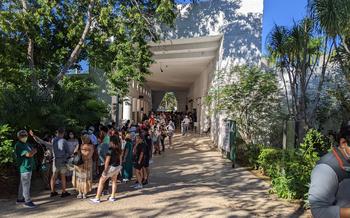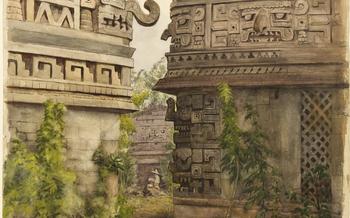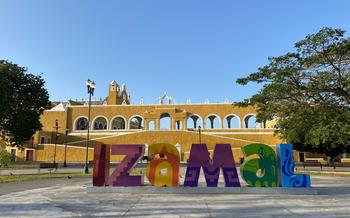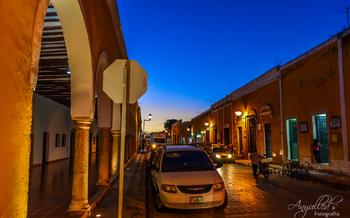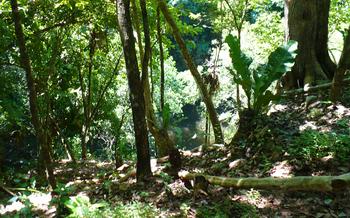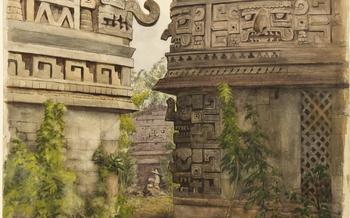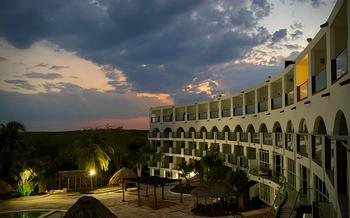
Cenote Xkeken and Samula
- Things to Do in Mexico, Merida - Visit the Cenote Xke have played a vital role in the region's history, culture, and environment. These underground water-filled sinkholes are formed by the collapse of limestone bedrock, creating unique and breathtaking geological formations. Cenotes have been a crucial source of water for the Maya people since ancient times, providing sustenance for agriculture, drinking, and religious ceremonies. They have also been revered as sacred places, believed to be portals to the underworld and the dwelling place of gods.
- The Spiritual Beliefs and Rituals Associated with the Cenotes
- Exploring Cenote Xkeken
- Discovering Cenote Samula
- Cultural Significance
- Photography and Videography
- Local Cuisine and Dining
- Explore the Mayan Cenotes: A Journey into History and Nature
- Packing Essentials
- Health and Safety Considerations
Things to Do in Mexico, Merida - Visit the Cenote Xke have played a vital role in the region's history, culture, and environment. These underground water-filled sinkholes are formed by the collapse of limestone bedrock, creating unique and breathtaking geological formations. Cenotes have been a crucial source of water for the Maya people since ancient times, providing sustenance for agriculture, drinking, and religious ceremonies. They have also been revered as sacred places, believed to be portals to the underworld and the dwelling place of gods.
In recent years, the cenotes of the Yucatán have gained popularity as tourist destinations, offering visitors the chance to swim, snorkel, dive, and explore these natural wonders. The clear waters, diverse marine life, and dramatic rock formations make the cenotes a must-visit for anyone interested in nature, adventure, and history.
The Spiritual Beliefs and Rituals Associated with the Cenotes
For the ancient Maya, cenotes were considered sacred places, imbued with spiritual significance. They were believed to be portals to the underworld, Xibalba, and the dwelling place of the rain god Chaac. Cenotes were used for religious ceremonies, offerings, and water rituals, and were often decorated with elaborate carvings and sculptures. The Maya believed that by throwing offerings into the cenotes, they could communicate with the gods and ensure a bountiful harvest.
Even today, the cenotes of the Yucatán retain their spiritual significance for the Maya people. Many Maya communities still perform ceremonies and rituals at the cenotes, seeking blessings, healing, and guidance from the spirits that reside within.
Exploring Cenote Xkeken
Among the must-visit cenotes in the Yucatan Peninsula is the enchanting Cenote Xkeken, renowned for its crystal-clear waters that shimmer in shades of turquoise and emerald. This natural wonder is surrounded by lush vegetation, creating a breathtaking oasis that invites visitors to immerse themselves in its pristine beauty.
At Cenote Xkeken, adventure seekers can indulge in a range of activities that cater to every preference. Swimming enthusiasts can glide through the crystal-clear waters, marveling at the diverse marine life that calls this cenote home. For those seeking a more thrilling experience, cliff jumping from various heights is a popular pastime, offering a rush of adrenaline as you plunge into the refreshing depths below.
To fully appreciate the underwater world of Cenote Xkeken, snorkeling and diving are highly recommended. With proper gear and guidance, you can explore the cenote's hidden chambers and encounter a variety of aquatic creatures, including colorful fish, turtles, and even the occasional crocodile.
When planning your visit to Cenote Xkeken, consider the time of day to optimize your experience. The early morning hours, before the crowds arrive, offer the best lighting conditions for photography and a more tranquil ambiance. Remember to bring appropriate swimwear, water shoes, and a towel, as well as sunscreen and insect repellent to protect yourself from the elements.
Discovering Cenote Samula
Cenote Samula stands out for its intimate and secluded atmosphere. Smaller in size compared to Cenote Xkeken, it offers a tranquil retreat from the bustling tourist crowds. Surrounded by lush vegetation and towering limestone walls, Cenote Samula exudes an enchanting aura of tranquility, inviting visitors to immerse themselves in its serene beauty.
The cenote's crystal-clear waters provide excellent visibility for swimming and snorkeling, allowing you to witness the diverse aquatic life that calls this cenote home. Snorkelers can glide through the water, marveling at the intricate coral formations and colorful tropical fish that dance around them.
For those seeking a more adventurous experience, Cenote Samula offers the opportunity to explore its underwater caves. With the guidance of experienced guides, visitors can venture into the hidden chambers and tunnels, discovering the secrets that lie beneath the surface.
Safety is paramount when exploring Cenote Samula. The cenote's relatively small size and limited visibility require extra caution. It's advisable to wear life jackets and avoid swimming alone. Additionally, be aware of potential underwater currents that may affect your navigation.
For a truly immersive experience, visit Cenote Samula early in the morning or late in the afternoon when the sun's rays create a magical play of light on the water's surface. The tranquil ambiance and serene beauty of this hidden gem make it an ideal spot for relaxation, contemplation, and connecting with nature's wonders.
Cultural Significance
Cenotes were highly revered by the ancient Mayans, who viewed them as sacred portals to the underworld. They played a vital role in Mayan religious ceremonies, offerings, and water rituals. Many cenotes were considered to be the abodes of powerful deities, including the rain god Chaac, and were often used for pilgrimage and offerings.
The Mayans believed that cenotes were connected to the afterlife, and they often performed rituals and ceremonies to honor the dead and communicate with their ancestors. Cenotes were also seen as a source of purification and spiritual renewal, and were often used for bathing and cleansing rituals.
The cultural significance of cenotes is still deeply ingrained in the Mayan communities of the Yucatan Peninsula. Many Maya families continue to visit cenotes for religious and spiritual purposes, and cenotes remain a source of inspiration for Mayan art, music, and storytelling.
Photography and Videography
The cenotes of Mexico offer a photographer's paradise, with their crystal-clear waters, dramatic rock formations, and vibrant marine life. To capture the best shots, consider using an underwater camera or a waterproof housing for your DSLR. Polarizing filters can help reduce glare and enhance the colors of the water and rock formations. Natural lighting is often best for capturing the beauty of the cenotes, so try to plan your visit during the golden hours of sunrise or sunset.
When taking photos or videos, be respectful of other visitors and their privacy. Always ask permission before taking someone's photo, and avoid disturbing the natural environment. Refrain from using flash photography, as this can disrupt the delicate ecosystem of the cenotes. Instead, use natural light or a soft LED light to illuminate your subjects.
By following these tips, you can capture stunning photos and videos of your cenote adventure that will serve as lasting memories of your trip to Mexico.
Local Cuisine and Dining
The Yucatan Peninsula is a culinary paradise, offering a tantalizing blend of traditional Mayan dishes and fresh seafood. When visiting Cenote Xkeken and Samula, be sure to savor the local delicacies. For an authentic Mayan experience, try cochinita pibil, a slow-roasted pork dish infused with achiote paste and wrapped in banana leaves. Another must-try is panuchos, fried tortillas topped with refried beans, shredded turkey, and pickled onions.
For seafood lovers, the coastal town of Progreso, just a short drive from the cenotes, offers a plethora of options. Indulge in freshly caught fish, shrimp, and lobster prepared in a variety of styles, including grilled, fried, and ceviche.
When choosing a restaurant, look for places that use fresh, local ingredients and traditional cooking methods. Ask your hotel or tour guide for recommendations, and don't be afraid to venture off the beaten path to discover hidden gems.
For a truly unique dining experience, consider visiting a local market. Here you can find a variety of fresh produce, spices, and handmade tortillas. You can also sample traditional Mayan dishes from street vendors, such as salbutes (fried tortillas with shredded turkey and pickled onions) and tamales (cornmeal dumplings filled with meat or vegetables).
Whether you're craving traditional Mayan cuisine or fresh seafood, the Yucatan Peninsula has something to satisfy every palate. So, be sure to come hungry and indulge in the culinary delights of this vibrant region.
Explore the Mayan Cenotes: A Journey into History and Nature
Accommodation Options
When planning your trip to Cenote Xkeken and Samula, choosing the right accommodation is essential for a comfortable and memorable experience. The Yucatan Peninsula offers a wide range of accommodation options, catering to different budgets and preferences.
For budget-conscious travelers, hostels and guesthouses provide affordable options with shared dormitories or private rooms. These accommodations often offer a social atmosphere and are a great way to meet fellow travelers.
Mid-range hotels and resorts offer more amenities and comfort, with private rooms, swimming pools, and restaurants. Many of these hotels are located near the cenotes, making it easy to explore the area.
For a truly unique and immersive experience, consider staying in a traditional Mayan village or a cenote-side cabaña. These accommodations offer a glimpse into the local culture and provide an opportunity to connect with the natural beauty of the region.
To secure the best deals and avoid disappointment, especially during peak tourist season, it's advisable to book your accommodation in advance. Online booking platforms and travel agents can help you find the best options and compare prices.
Packing Essentials
When packing for a trip to the cenotes, it's crucial to bring items that ensure comfort, safety, and enjoyment during your adventure. Here's a list of essential items to consider:
-
Swimwear: Opt for comfortable and quick-drying swimwear that allows for movement and exploration in the water.
-
Water Shoes: Protect your feet from sharp rocks and slippery surfaces with water shoes that provide good grip and support.
-
Towels: Bring along a lightweight and absorbent towel to dry off after swimming or lounging by the cenote.
-
Sun Protection: The Yucatan Peninsula experiences intense sunlight, so pack sunscreen with a high SPF, sunglasses, and a hat to shield yourself from harmful UV rays.
-
Hydration Pack: Stay hydrated by bringing a reusable water bottle or a hydration pack to replenish your fluids during your cenote explorations.
-
Camera: Capture the beauty of the cenotes with a waterproof camera or a smartphone with a waterproof case to document your underwater adventures.
-
Headlamp or Flashlight: If you plan to explore cave cenotes or venture into darker areas, bring a headlamp or flashlight to illuminate your surroundings.
-
First-Aid Kit: Pack a basic first-aid kit with essential supplies like bandages, antiseptic wipes, and pain relievers to address minor injuries or ailments.
-
Insect Repellent: Protect yourself from pesky insects by bringing insect repellent with DEET or a natural alternative.
-
Cash: While some cenotes may accept credit cards, it's always a good idea to carry cash for entrance fees, local vendors, and small purchases.
Remember to pack light and efficiently, especially if you're traveling for an extended period. Prioritize items that are versatile and suitable for various activities, and consider leaving behind bulky or unnecessary items to make your journey more comfortable and enjoyable.
Health and Safety Considerations
Before embarking on your cenote adventure, it is crucial to prioritize your health and safety. Vaccinations for diseases such as Hepatitis A and Typhoid are recommended to protect against waterborne illnesses. Insect repellent is essential to ward off mosquitoes and other insects that may carry diseases. Proper hydration is vital, especially in the hot and humid climate of the region. Drink plenty of water to avoid dehydration.
Be aware of potential safety hazards, including petty crime and scams. Keep your belongings close and be cautious when dealing with strangers. Yucatan is generally safe, but it is always advisable to exercise basic precautions.
The cenotes are natural wonders, but they can also pose risks. Always swim with a buddy and be mindful of your surroundings. Avoid diving into shallow waters or areas with overhanging rocks. Wear appropriate footwear, such as water shoes, to protect your feet from sharp rocks and slippery surfaces.
Be aware of natural hazards like hurricanes, which can occur during the rainy season (June to November). Monitor weather forecasts and be prepared to seek shelter if necessary. Always listen to the advice of local authorities and follow safety guidelines posted at the cenotes.
